
Wings is a 1927 American silent and synchronized sound film known for winning the first Academy Award for Best Picture. Due to the general public's apathy towards silent films, the film was quickly re-released in 1928 with synchronized sound. While the sound version of the film has no audible dialog, it was released with a synchronized musical score with sound effects. The film stars Clara Bow, Charles "Buddy" Rogers, and Richard Arlen. Rogers and Arlen portray World War I combat pilots in a romantic rivalry over a woman. It was produced by Lucien Hubbard, directed by William A. Wellman, and released by Paramount Famous Lasky Corporation. Gary Cooper appears in a small role, which helped launch his career in Hollywood.

The La Fayette Escadrille was the name of the French Air Force unit escadrille N 124 during the First World War (1914–1918). This escadrille of the Aéronautique Militaire was composed largely of American volunteer pilots flying fighters. It was named in honor of the Marquis de Lafayette, French hero of the American Revolutionary War. In September 1917, the escadrille was transferred to the US Army under the designation 103rd Aero Squadron. In 1921, The French Air Force recreated a N124 unit who claimed lineage from the war-time La Fayette escadrille and is now part of the escadron 2/4 La Fayette.

Tab Hunter was an American actor, singer, film producer, and author. Known for his blond hair and clean-cut good looks, Hunter starred in more than forty films. During the 1950s and 1960s, in his twenties and thirties, Hunter was a Hollywood-heartthrob, acting in numerous roles and appearing on the covers of hundreds of magazines. His notable screen credits include Battle Cry (1955), The Girl He Left Behind (1956), Gunman's Walk (1958), and Damn Yankees (1958). Hunter also had a music career in the late 1950s; in 1957, he released a no. 1 hit single "Young Love". Hunter's 2005 autobiography, Tab Hunter Confidential: The Making of a Movie Star, was a New York Times bestseller.

William Augustus Wellman was an American film director, producer, screenwriter, actor and military pilot. He was known for his work in crime, adventure, and action genre films, often focusing on aviation themes, a particular passion. He also directed several well-regarded satirical comedies. His 1927 film, Wings, was the first film to win an Academy Award for Best Picture at the 1st Academy Awards ceremony.

Island in the Sky is a 1953 American aviation adventure drama film written by Ernest K. Gann based on his 1944 novel of the same name, directed by William A. Wellman and starring and coproduced by John Wayne. Because of its realistic depiction of an actual aircraft crash, some consider the film as among the classic aviation films. The film also features Andy Devine, Lloyd Nolan, James Arness and Paul Fix.
Darby's Rangers is a 1958 American war film starring James Garner as William Orlando Darby, who organizes and leads the first units of United States Army Rangers during World War II. Directed by William Wellman, the picture was shot by Warner Brothers Studios in black and white, to match wartime stock footage included in the production. It was inspired by the 1945 book Darby's Rangers: An Illustrated Portrayal of the Original Rangers, by Major James J. Altieri, himself a veteran of Darby's force.

The Last Flight is a 1931 American pre-Code ensemble cast film, starring Richard Barthelmess, David Manners, John Mack Brown and Helen Chandler. It was directed by German filmmaker William Dieterle in his debut as an English-language film director.
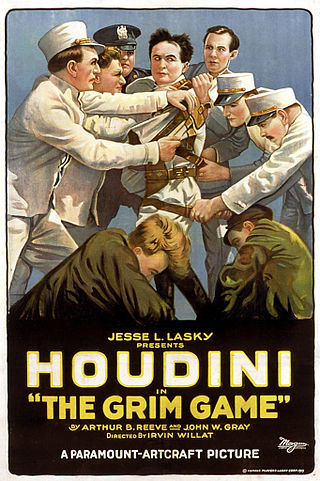
The Grim Game is a 1919 American silent drama film directed by Irvin Willat and starring Harry Houdini and Ann Forrest. The basic plotline serves as a showcase for Houdini's talent as an escapologist, stunt performer and aviator. As the story unfolds, a series of Houdini's trademark set-piece stunts and escapes are performed. When his tormentors chain him up and imprison him on numerous occasions, Houdini escapes. The film concludes with a climactic mid-air collision following an aircraft pursuit. Following the collision, Houdini is reunited with his fiancée.
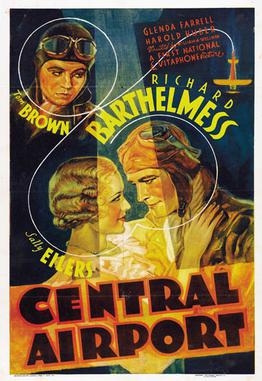
Central Airport is a 1933 American pre-Code aviation drama film directed by William A. Wellman, based on the John C. "Jack" Moffitt story, "Hawk's Mate". The film stars Richard Barthelmess and Sally Eilers. Central Airport was produced and released by Warner Bros., on April 15, 1933. John Wayne had an uncredited part in the film, playing a co-pilot, and this film features his first on-screen death.

Gallant Journey is a 1946 American historical film written, produced and directed by William A. Wellman and starring Glenn Ford, Janet Blair and Charles Ruggles. The film is a biopic of the early U.S. aviation pioneer John Joseph Montgomery. Gallant Journey depicts his efforts to build and fly gliders, from his childhood through to his death in 1911. The chief stunt pilot for the film was Paul Mantz. It was produced and distributed by Columbia Pictures. It is also known by the alternative title The Great Highway

The Legion of the Condemned is a 1928 American silent film directed by William A. Wellman and produced by Jesse L. Lasky, Wellman, and Adolph Zukor and distributed by Paramount Pictures. Written by former World War I flight instructor John Monk Saunders and Jean de Limur, with intertitles by George Marion, Jr., the film stars Fay Wray and Gary Cooper.
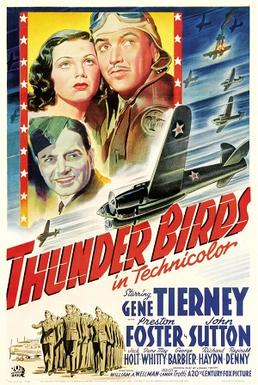
Thunder Birds is a 1942 Technicolor film directed by William A. Wellman and starring Gene Tierney, Preston Foster, and John Sutton. It features aerial photography and location filming at an actual Arizona training base of the United States Army Air Forces named Thunderbird Field No. 1 during World War II.

Chain Lightning is a 1950 American aviation film based on the story "These Many Years" by blacklisted writer Lester Cole ; the screenplay was written by Liam O'Brien and Vincent B. Evans. During World War II, Evans had been the bombardier on the Boeing B-17 Flying Fortress Memphis Belle.

Flying Blind is a 1941 American action comedy film directed by Frank McDonald and distributed by Paramount Pictures. The film was the second movie from Pine-Thomas Productions. That company's first three films formed an unofficial "aviation trilogy"; all starred Richard Arlen.
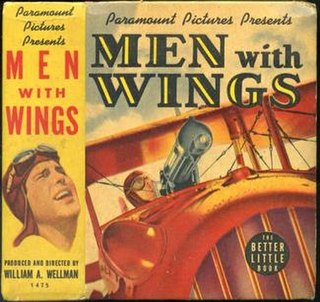
Men with Wings is a 1938 American Technicolor war film, directed by William A. Wellman and starring Fred MacMurray, Ray Milland, and Louise Campbell. Donald O'Connor also has a small part as the younger version of MacMurray's character. The two would soon star in the film Sing You Sinners together along with Bing Crosby.

Young Eagles is a 1930 American pre-Code romantic drama film directed by William A. Wellman for Paramount Pictures. It stars Charles "Buddy" Rogers, Jean Arthur, and Paul Lukas. The story is based on the stories "The One Who Was Clever" and "Sky-High", written by American aviator and war hero Elliott White Springs. The film's hero is a "heroic combat aviator of the Lafayette Escadrille".

Flying Fortress is a 1942 British black-and-white war film drama from Warner Bros. Pictures, produced by A. H. Soloman, directed by Walter Forde, that stars Richard Greene and co-stars Carla Lehmann, Betty Stockfeld, and Donald Stewart.
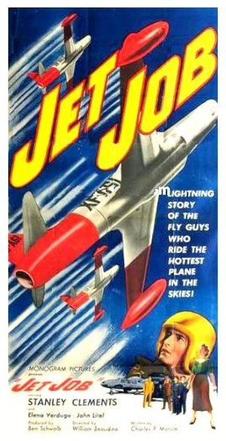
Jet Job is a 1952 American aviation action film directed by William Beaudine. The film stars Stanley Clements, John Litel and Bob Nichols. Jet Job features stock footage of various types of USAF military aircraft.
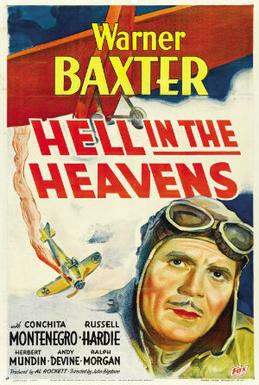
Hell in the Heavens is a 1934 American aviation drama film directed by John G. Blystone and written by Byron Morgan, Ted Parsons and Jack Yellen based on the stage play Der Flieger by Hermann Roßmann. The film stars Warner Baxter, Conchita Montenegro, Russell Hardie, Herbert Mundin, Andy Devine and William Stelling. It was released on November 9, 1934 by Fox Film Corporation.

A Romance of the Air is a 1918 American silent drama film based on the book En L'air (1918), by Bert Hall, one of America's first combat aviators, flying with the famed Lafayette Escadrille in France before the United States entered World War I. Directed by Harry Revier, the film was heavily influenced by the exploits of Hall, who was featured in the film and took an active role in promoting and marketing A Romance of the Air.





















